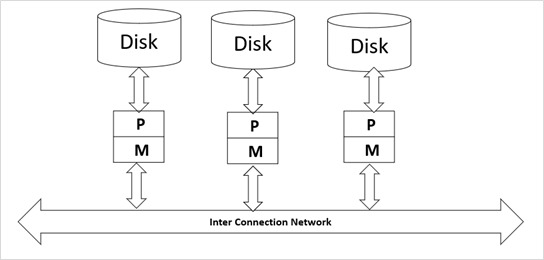
 Data Structure
Data Structure Networking
Networking RDBMS
RDBMS Operating System
Operating System Java
Java MS Excel
MS Excel iOS
iOS HTML
HTML CSS
CSS Android
Android Python
Python C Programming
C Programming C++
C++ C#
C# MongoDB
MongoDB MySQL
MySQL Javascript
Javascript PHP
PHP
- Selected Reading
- UPSC IAS Exams Notes
- Developer's Best Practices
- Questions and Answers
- Effective Resume Writing
- HR Interview Questions
- Computer Glossary
- Who is Who
What is shared nothing architecture in parallel databases?
In parallel database system data processing performance is improved by using multiple resources in parallel. In this CPU, disks are used parallel to enhance the processing performance.
Operations like data loading and query processing are performed parallel. Centralized and client server database systems are not powerful enough to handle applications that need fast processing.
Parallel database systems have great advantages for online transaction processing and decision support applications. Parallel processing divides a large task into multiple tasks and each task is performed concurrently on several nodes. This gives a larger task to complete more quickly.
Architectural Models For Parallel Database
There are several architectural models for parallel machines, which are given below −
- Shared memory architecture.
- Shared disk architecture.
- Shared nothing architecture.
- Hierarchical architecture.
Shared nothing Architecture
Let us discuss shared nothing architecture.
Shared nothing architecture − In this each node has its own mass storage as well as main memory. The processor at one node may communicate with another processor at another node by a high speed interconnection network. The node functions as the server for the data on the disk or disks that the node owns as each processor has its own copy of OS, DBMS and data.
Examples − Teradata, Gamma, Bubba.
Given below is the diagram of the shared nothing architecture −

Advantages
The advantages of the shared nothing architecture are as follows −
The interconnection network for shared-nothing models is usually designed to be scalable so that their transmission capacity increases as more nodes are added.Thus these architectures are more scalable and easily support a large number of processors.
It overcomes the disadvantages requiring all I/O to go through a single intercommunication network.
It provides linear speed-up and linear scale-up that is time taken for operations decreases in proportion to the increase in the number of CPU’s and disks; scale-up means the performance is sustained if the number of CPU’s and disks are increased in proportion to the amount of data.
Disadvantages
The disadvantages of the shared nothing architecture are as follows −
CPU to CPU communication is very slow.
The cost of communication and no-local disk access are higher than shared memory or shared disk architecture because sending data involves software interaction at both sides.
Shared nothing architecture is difficult to load balance.

